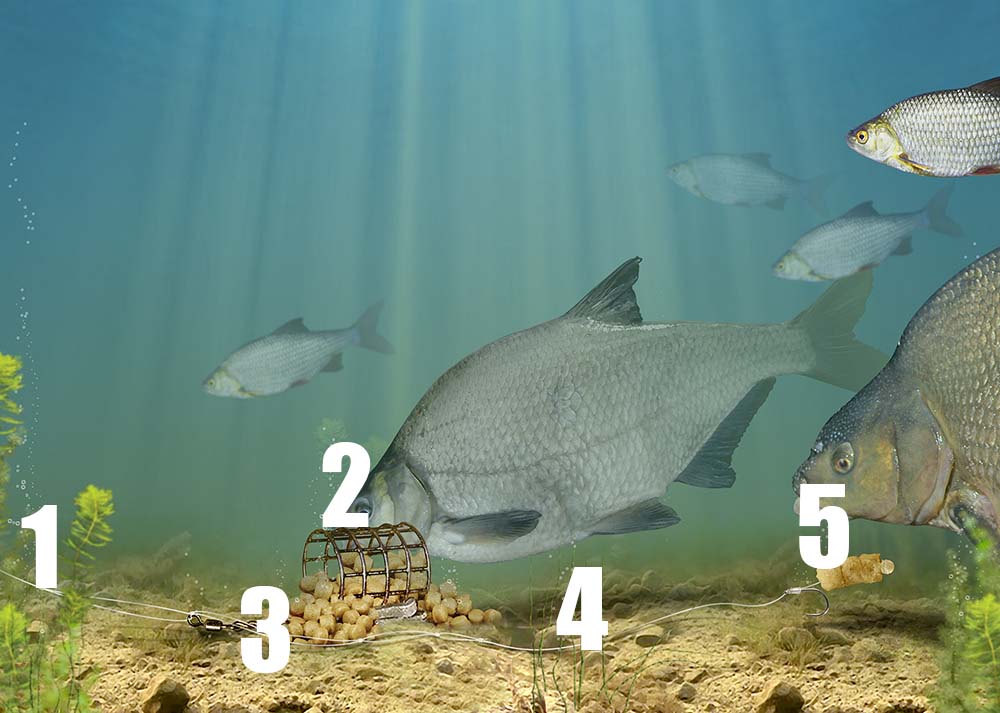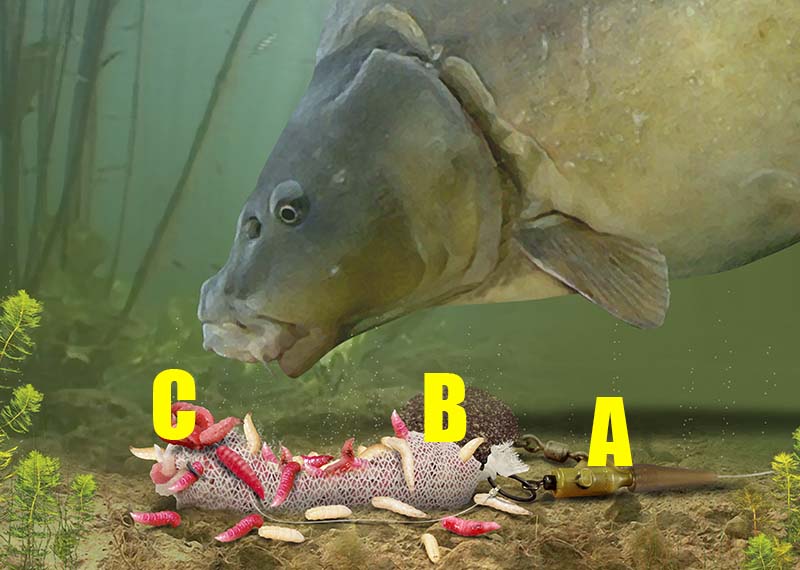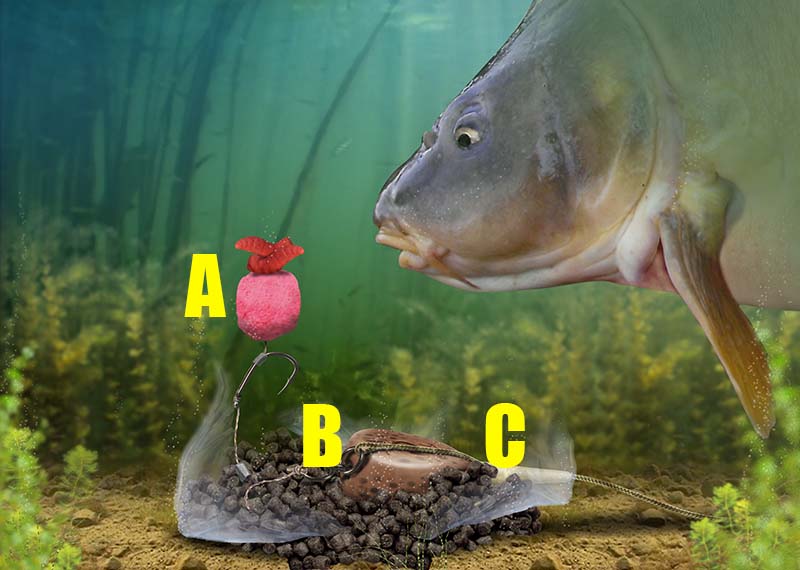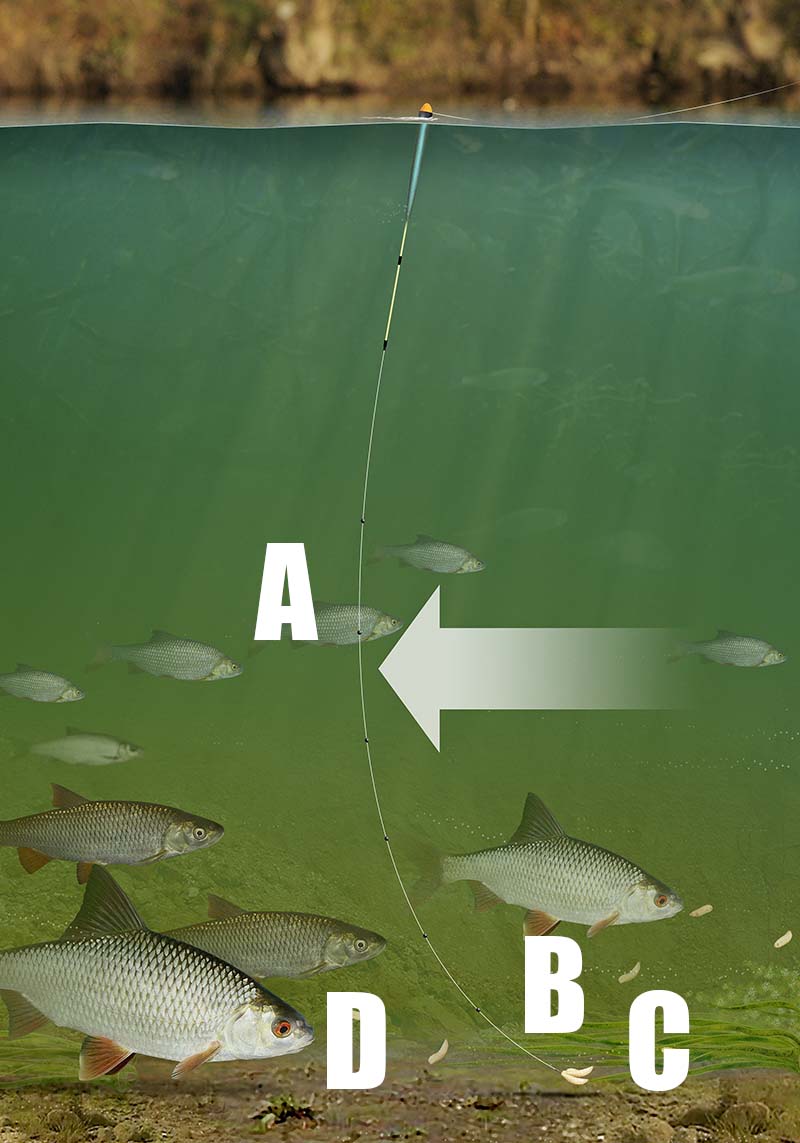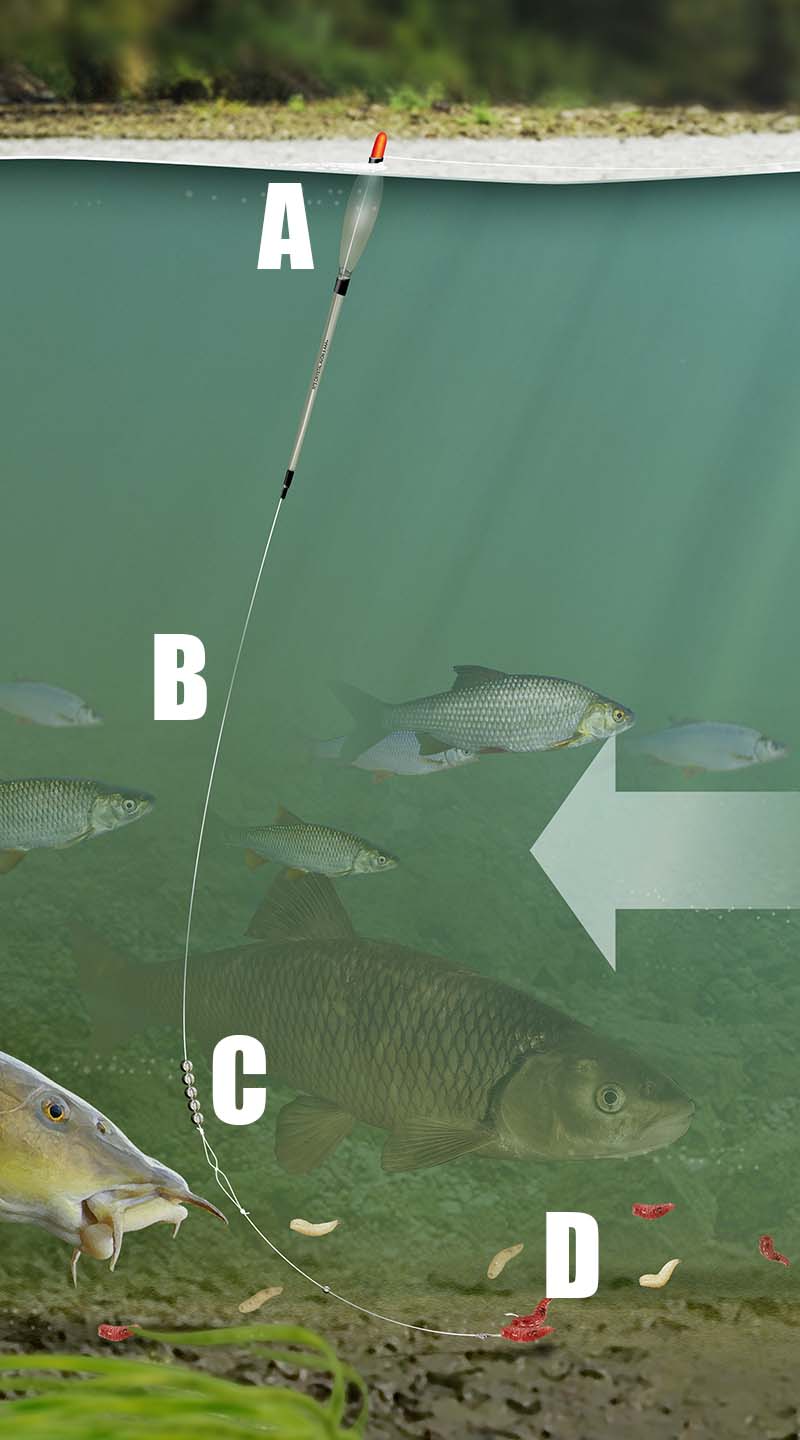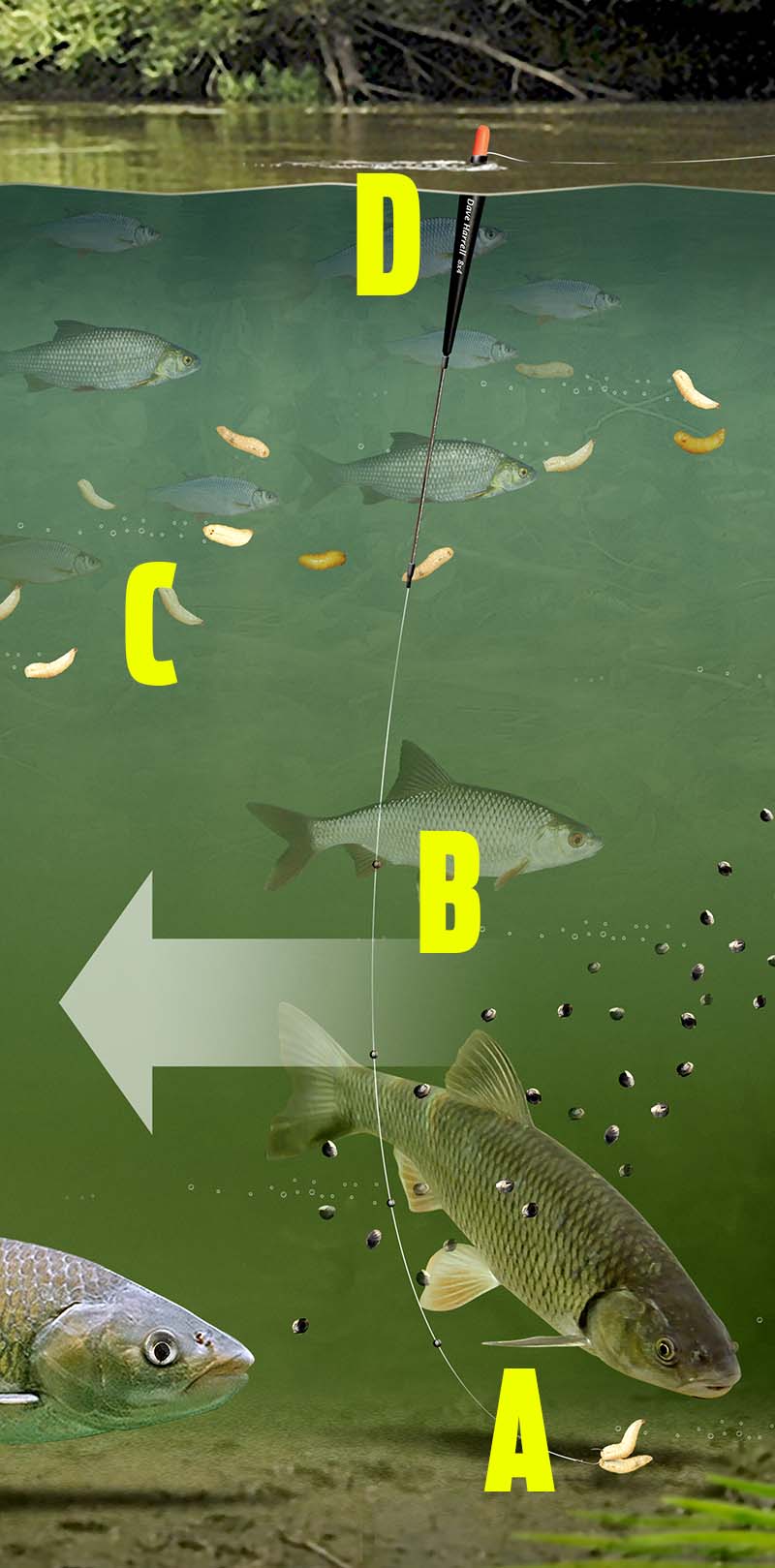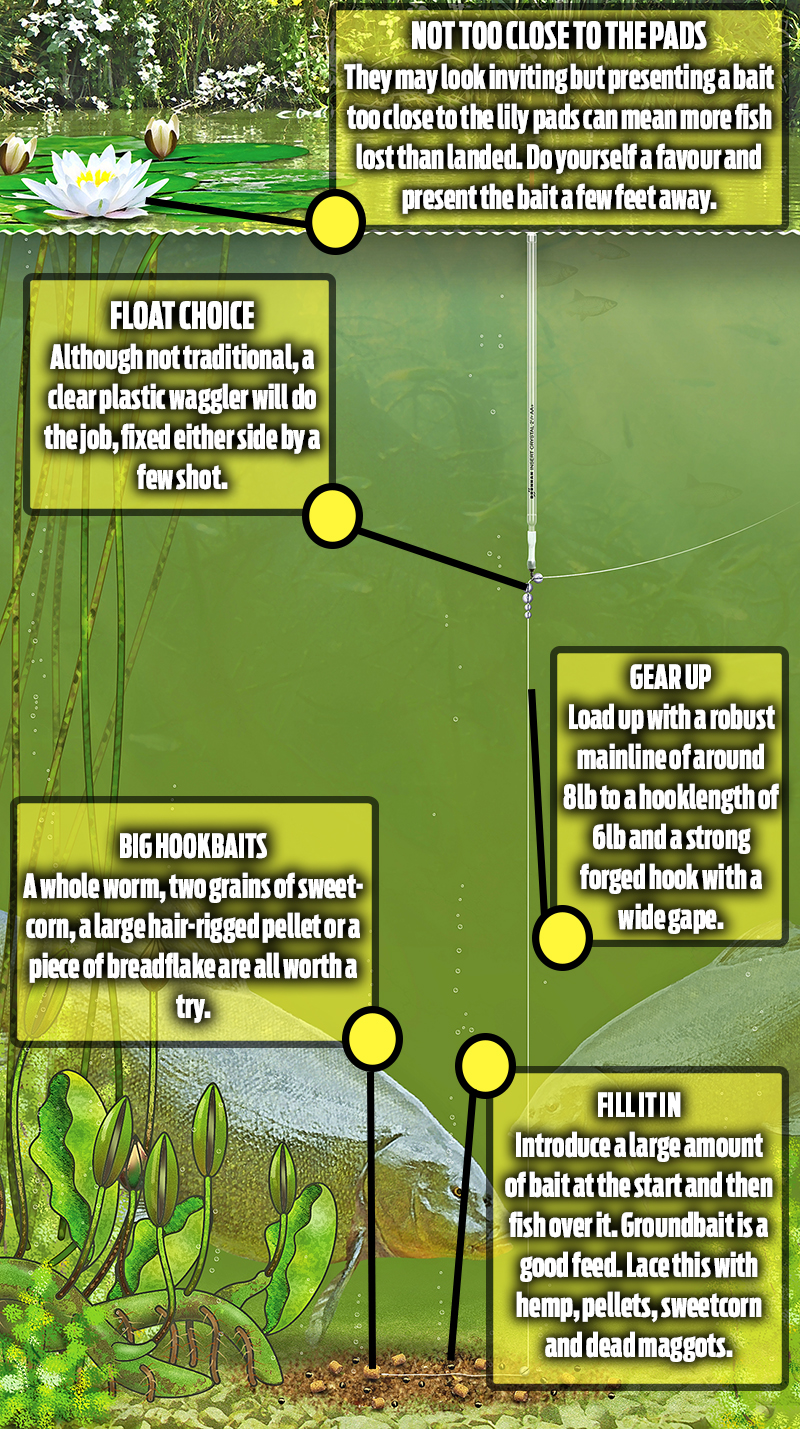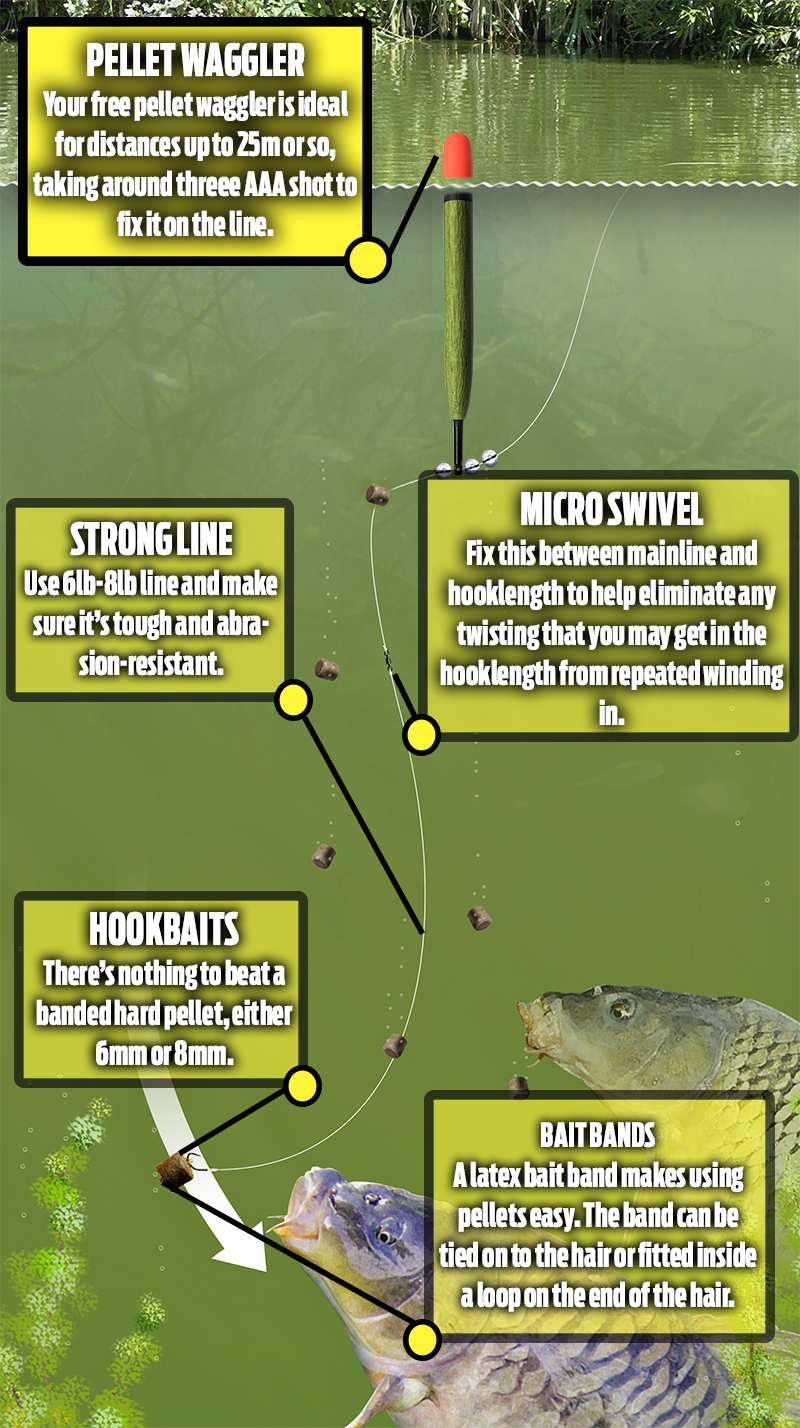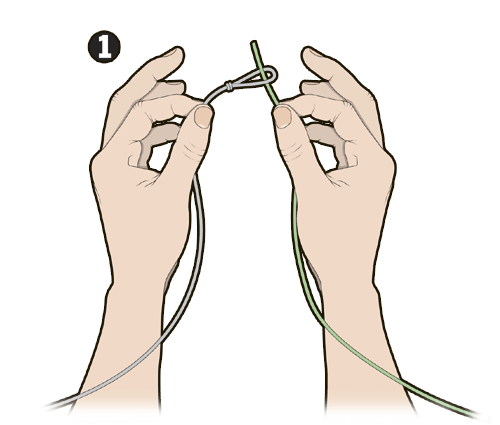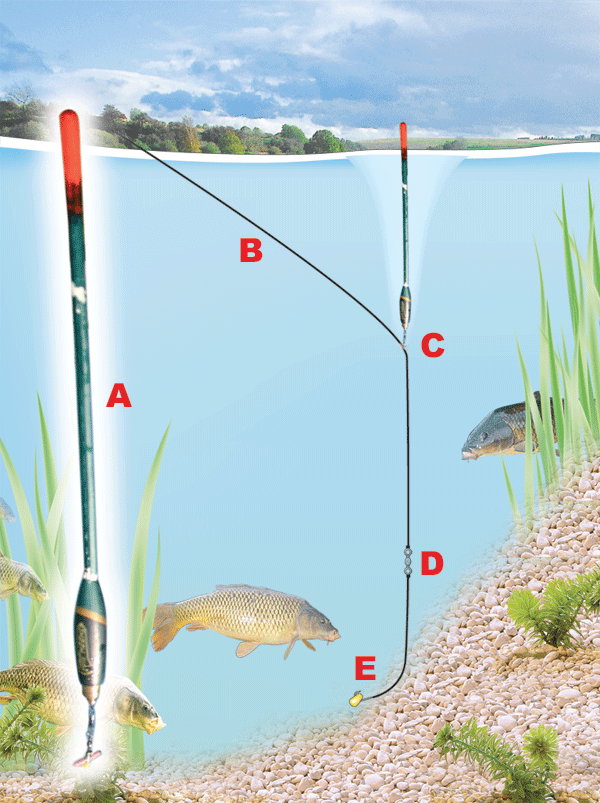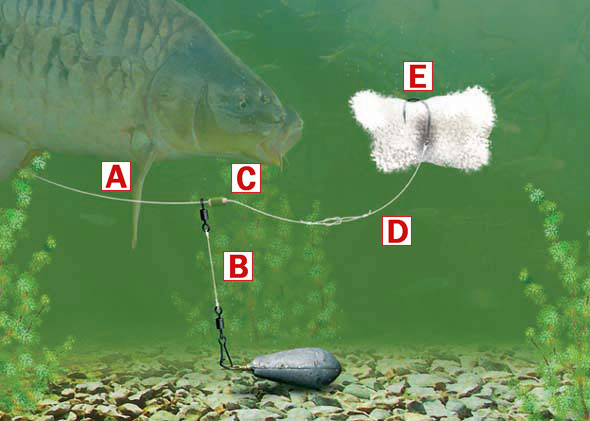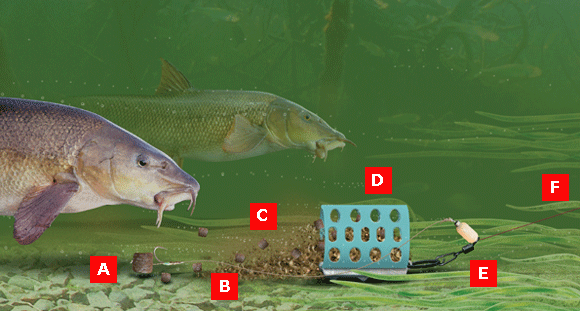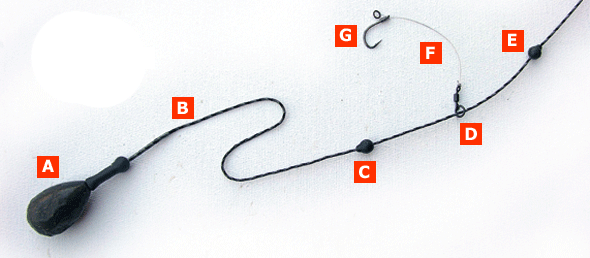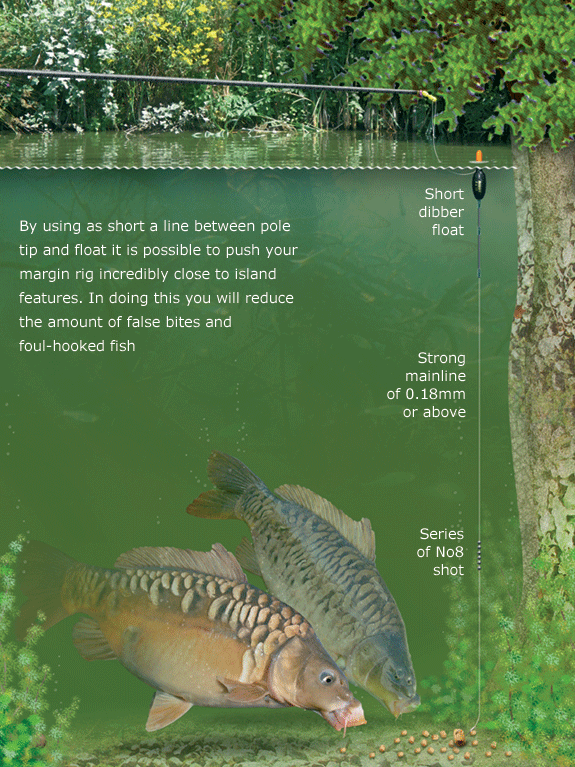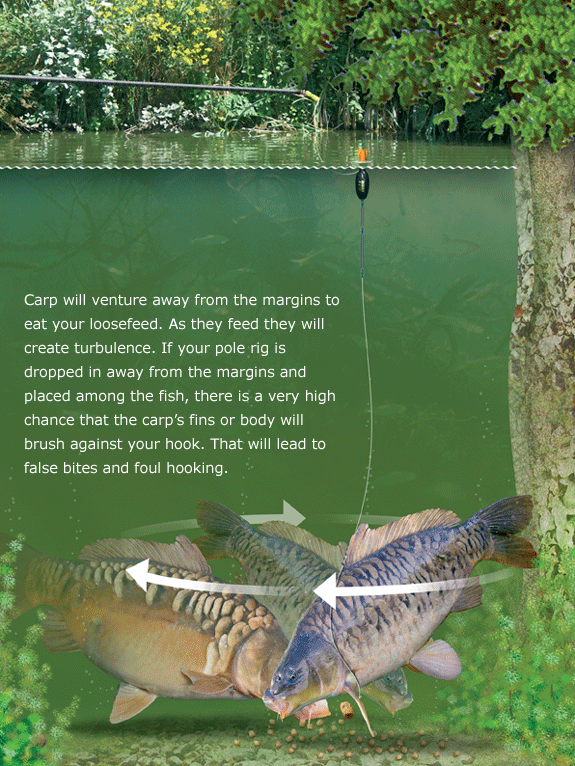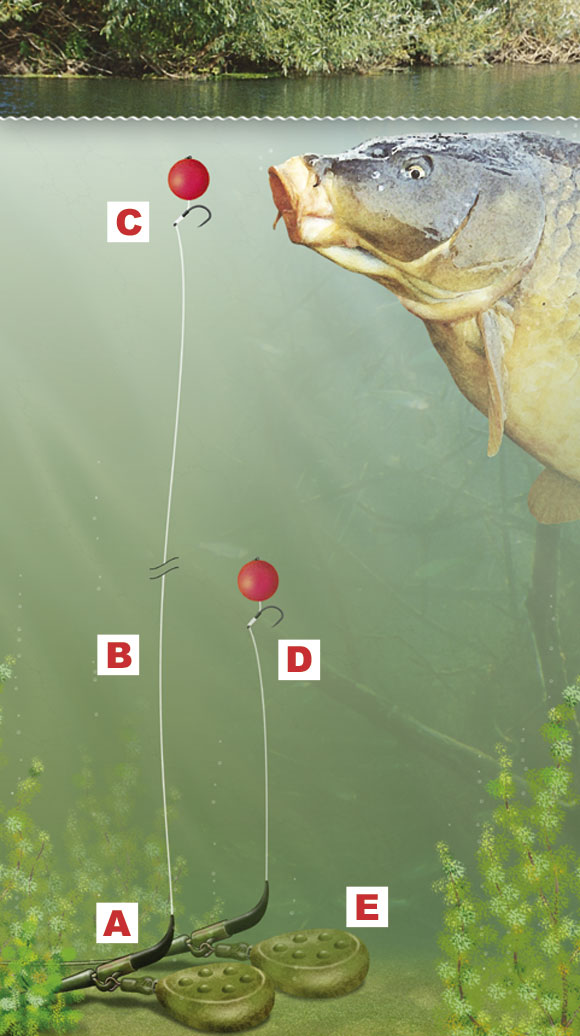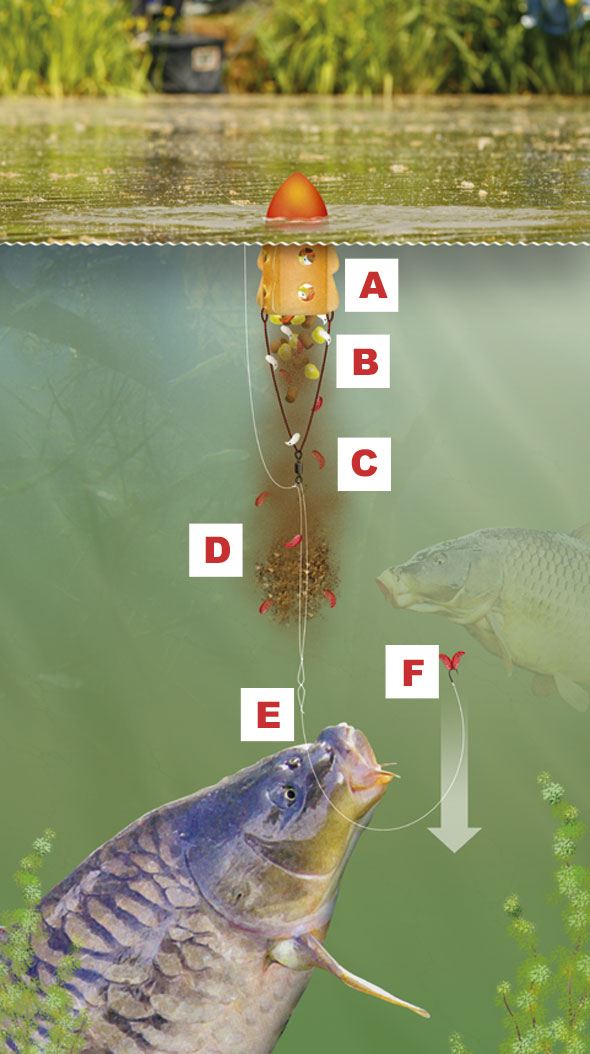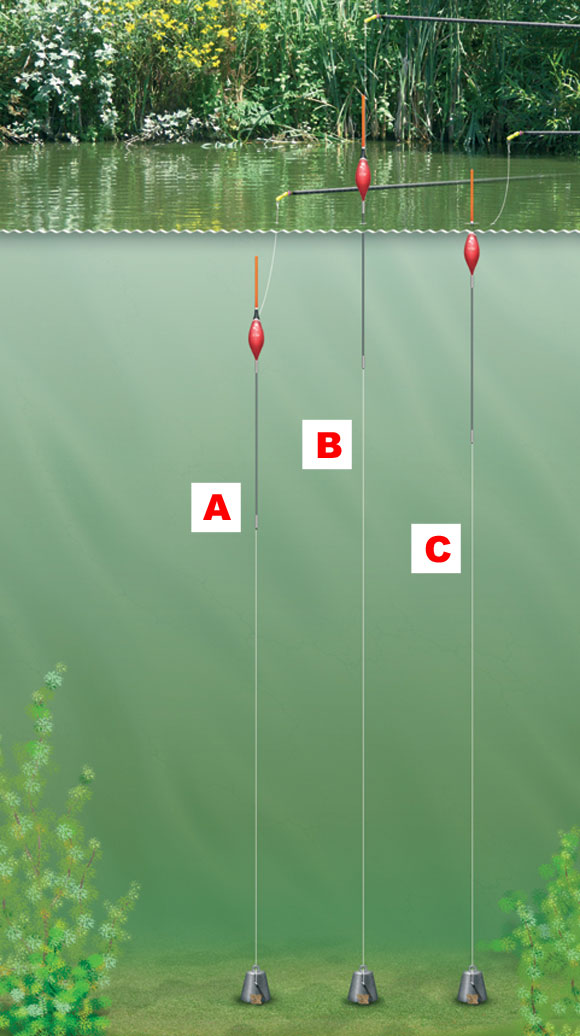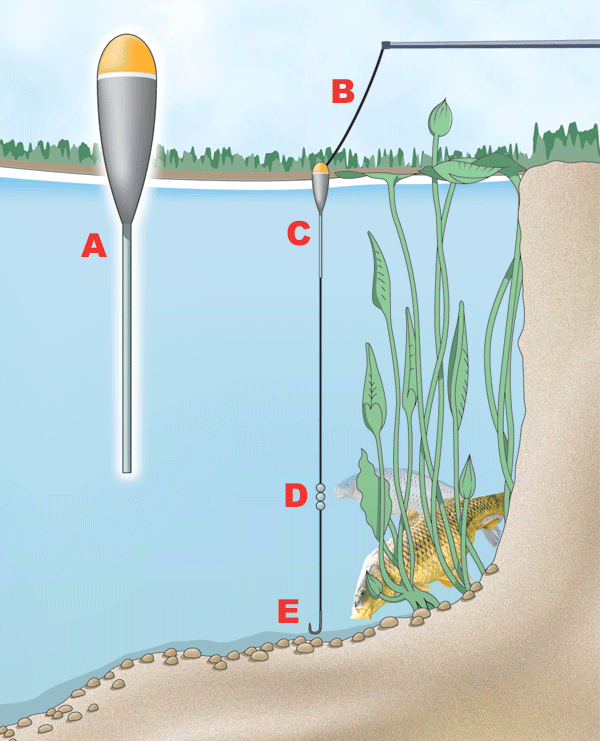How to tie | The stealth pellet waggler rig
Setting up this pellet waggler rig couldn’t be easier if you think about how to get the best results from the rig that you are using follow our simple and easy steps to helping you tie one of these great pellet waggler rigs
1) Foam wagglers are relatively light so I fish them on 5lb Guru Pulse mainline to get maximum distance on the cast.
2) Purpose-built weighted adaptors for all three sizes of foam waggler mean you don’t have to put shot on light mainline, which could potentially damage it. These adaptors take the float down to the perfect level, and help it sit immediately.
3) A Guru pellet waggler snap link swivel allows me to change the size of waggler quickly and without fuss when the need arises.
4) To keep the waggler in place I use three small line stops. That way I can chop and change the depth without fear of damaging the line.
5) Below this I tie on a size 14 Cralusso Quick Snap Swivel which allows me to quickly change my hooklength while keeping everything neat and free from tangles.
6) For this type of fishing I tie my hooklengths 12ins long and for carp in the 4lb-10lb bracket I will use 0.17mm N-Gauge.
7) The hook will be either a size 16 or 18 super MWG pattern, depending on the size of pellet on the bait band. I’ll start with the rig set around 18ins deep with a view to coming higher in the water as the day progresses. I always prefer to start deeper, because that way I can get a better impression of what’s going on below the surface
How to tie | The rocket feeder carp rig
There are many different ways of catching carp up in the water, but one of the most effective is the Rocket Feeder.
As the name suggests, this is a floating feeder that is open at one end, enabling it to be filled with lightly dampened pellets or groundbait, which should be mixed so that it quickly exits the feeder once cast out.
Unlike other tactics, the Rocket Feeder is ideal for use with larger pellets, such as 8mm baits, enabling the angler to introduce sizable food items – ideal for larger carp. The feeder can also be cast long distances, thanks to its aerodynamic shape, so it’s useful when carp are beyond pellet waggler range.
The shape of the feeder means that it acts as a very effective bolt-rig when a carp takes the bait. In fact, it is essential to use strong line with this tactic to avoid being broken on the take. A minimum of 6lb is recommended.
Set the Rocket Feeder about 4ft above the hook then, as the carp become more accustomed to the stream of bait, move the float stops down so that the hookbait is just 2ft deep.
On heavily stocked carp fisheries the Rocket Feeder is an absolute winner at this time of the year. Get on it now!
Slide a float stop on to the mainline, followed by the Rocket Feeder, and then fix two further float stops to lock it in place
Adjust the float stops to lock the feeder in position. Having two stops below the feeder ensures that it will not move on the cast
The feeder should be locked about 3ft above the end of the mainline
Tie a figure-of-eight knot in the end of the mainline to form a small loop which you will attach the hooklength to
Use a four-turn grinner knot to attach the hook. Use a clear line a this is less visible when fishing up in the water
The hooklength should be 1ft long and attached to the mainline using a loop-to-loop knot. Attach the hookbait using a bait band
Top 5 pole rigs that you need to try!
No matter where you choose to fish this month, you can guarantee that your target species will come close to the bank in search of food now that the temperatures have risen sharply.
When this happens, the pole is an unbeatable item of tackle but the sort of rig you use with it will dictate whether you get just a few bites or have a session that you won’t forget in a hurry.
Paying careful attention to your terminal tackle and bait choices is vital if you want to make the most of your time on the bank, as is getting the subtle details such asshotting and float patterns spot on.
We reveal the five most deadly spring pole rigs that are almost certain to help you and your friends put more fish in the net.
The Worm Rig
GOOD FOR: Putting together big mixed bags of quality bream and tench on stillwaters.
TACKLE: Use a rugby ball-shaped float with 5lb mainline, a 4lb hooklength and size 14 or 16 hook.
HOOKBAIT: Half or a full worm will appeal to both species at this time of year.
The Maggot Rig
GOOD FOR: Quality roach that will only feed if the hookbait looks natural.
TACKLE: Keep it light with 3lb mainline, a 2lb hooklength and a size 18 or 20 hook.
HOOKBAIT: Red maggots will keep the bites coming. Alternate between single and double.
The Pellet Rig
GOOD FOR: Catching F1s and carp in open water swims on commercials.
TACKLE: A narrow float will help you spot every bite. Use 5lb mainline to a 4lb hooklength and a size 16 hook.
HOOKBAIT: Start with a 4mm expander, switching to a banded pellet if small fish show.
The Margin Rig
GOOD FOR: Catching the biggest carp and F1s in the lake, especially late in the session.
TACKLE: Don’t risk getting bust by a big carp and use 6lb mainline to a 5lb hooklength. A strong float with a thick tip is a must.
HOOKBAIT: Corn is unbeatable in the margins.
The Meat Rig
GOOD FOR: Fishing in open water for carp, F1s, big bream and tench on commercials.
TACKLE: A balanced rig helps catch all species. Use 5lb mainline, 4lb hooklength to a size 16 hook.
HOOKBAIT: A 6mm cube of meat will catch all species that are stocked in the fishery.
Three pellet waggler rigs to fish this weekend!
A waggler is the most versatile float of all, capable of catching fish from rivers, canals, commercials and massive natural lakes.
But within the waggler family there are groups of floats that have very definite roles to perform. These include the pellet waggler for distance fishingup in the water, and see- through plastic floats for use on gin clear waters.
At this time of year, when the weather can change drastically from one day to the next, being adaptable is the key to catching.
To make sense of the types of waggler, how the rig should be set up and the best baits and feeds to use, try these rigs that will cover just about every base over the next few weeks…
Insert waggler rig for silver fish
Fish can be caught on commercials at a range of depths in spring, so if there was one versatile float to pick it’d have to be the insert waggler. This rig is a simple to make waggler set-up for tackling a typical lake swim up to 8ft deep.
Waggler rig for tench
There are few more evocative sights in fishing than a float poised next to a patch of lilies, ringed by the tell-tale pinhead bubbles of feeding tench. This rig allows you to fish what’s known as the ‘lift’ method, using a large shot on the lakebed.
Pellet waggler rig
The pellet waggler rig is all the rage right now but how do you fish it? Well setting the pellet waggler up is easy to do and a brilliant option in May and June when the weather starts to warm up.
Tommy Pickering | How to make my simple groundbait feeder rig!
This is my favourite set-up for all my open end feeder fishing. It’s a very simple rig for wire cage and plastic frames, and the stiff boom which is tied in the end of the mainline means tangles are kept to a minimum.
As it’s free running it’s completely safe, too. Use it for bream, tench, roach, perch and even carp. All you need is your reel line, your feeder with a swivel eye or snap link attached, a packet of No8 Preston Stotz weights and your chosen hooklength.
Try this simple and tangle-free feeder set up.
Step 1.
Take the mainline or shockleader between thumb and first finger of both hands and twist in opposite directions to twizzle it together.
Step 2.
Ensure that the length of the twizzled line is longer than that of the feeder and link, to stop the two tangling when you cast the finished rig.
Step 3.
Bring the twisted line back over itself to form an overhand loop knot. Pass the end through itself twice and pull to tighten the knot properly.
Step 4.
You’re now left with a twisted section of line of around 6ins long, called a boom. Trim the tag end to reduce line spin when reeling in.
Step 5.
Now slide the swivel eye of the snap link attached to your feeder on to the twisted line and over the knot of the stiff boom.
Step 6.
Attach two No8 Stotz to the mainline just above the twisted section, with the feeder above. These butt against the knot and stop the feeder too.
Step 7.
Time to add your hooklength, which you will probably have already tied. Push the hooklength loop over the end of the twisted boom.
Step 8.
Put the hook itself through the end loop in the twisted boom. Then pull the whole hooklength through with it as it goes through.
Step 9.
The loop-to-loop forms like this - you may need to flick the hooklength over its own loop knot to achieve this perfect connection. Pull tight.
How to tie Alan Scotthorne's Hooklength Knot
Here Alan Scotthorne reveals the knot that he uses to join a hooklength to his fishing mainline. It's a variation of the loop-to-loop method, but with a twist. It's easy to tie and incredibly strong...
Alan Scotthorne was never really happy with using loop to loop knots for joining his mainline to his hooklength namely because it can potentially cause tangles and it's untidy.
After experimenting with lines he came up with this knot. Well, it's actually not really a knot - it's more of a way of wrapping and twisting a line onto a loop of line. This makes this knot very strong indeed, and therefore reliable enough to be used on silverfish through to commercial carp waters.
But it's developer and creator proves just how reliable and effective this knot it. If it's good enough to a five-times World Champion to use, it must be good enough for every other angler!
Here's how it's tied...
1 Tie a small loop in the end of your mainline and then pass your hooklength line through the loop like this.
2 Hold the line in your left hand and then double it up with your other hand to create a loop in the hooklength line.
3 Twist the end of the hooklength that is held in your right fingers. This causes the line to spin and twist around the other section of hooklength line.
4 Pass the other end of line, with your hook attached, through the loop that is created when twisting the hooklength line.
5 Moisten the line and pull the knot tight. The tag ends should be trimmed right down as this knot refuses to slip.
How to fish the lift method for carp, tench and bream
This technique is brilliant for tackling the margins. It was made famous by John Wilson, who has used it extensively for carp on many of Britain's lakes to catch countless fish of all sizes. It works with almost all baits, including boilies.
A The lift method works best if the float rod is placed upon rod rests. This ensures that the rod tip and the line remains stationary, and subsequently the float isn't pulled off line.
B It's best to use large, unloaded floats that offer a lot of buoyancy. When set correctly the float tip should only just break the surface. When a fish takes the bait and therefore lifts the shot that lies on the bottom, the float will rise to indicate a bite.
C Use the bare minimum of shot to lock the float upon the line. Ideally the shot should not even make the float lay flat on the water's surface - that's how little this rig requires around the float.
D You will need to plumb the depth accurately when using this rig because all the float's shot loading needs to ble placed well down the line so that it sits on the bottom. This not only anchors the float, but if it is placed at the correct depth it will pull the float down so low that only the tiniest hint of the sight tip shows above the water's surface.
Rig for floatfishing close to islands and features
This float rig is ideal when casting tight to an island to catch the carp that patrol around its margins. As you will be casting to a feature you can actually use this rig with the line clipped up because a hooked fish will not be able to swim away from you - it can only swim to the side or towards you.
A Use a loaded, bodied float that is attached to the line with a fixed float adaptor. Alternatively a couple of tiny split shot will suffice. The best float to use is a straight bodied waggler because they pop up to the surface very quickly, ready to detect a bite straight away.
B Mainline needs to be strong enough to cope with carp and the problem of hooked fish reaching any snags. We suggest using no lighter than 4lb.
C Make sure that the depth is plumbed accurately so that the rig is set cotrrectly and that the bait touches the bottom.
D By using a swivel to link the mainline to the hooklength esnures that a replacement hooklength can be attached quickly, and as this rig will be cast a lot of times, the hooklength will not spin up as the bait revolves when it is being drawn back to the bank.
E Ideal hooklengths for this rig need to be 0.14mm and above. The best baits for this style of fishing are either sweetcorn, maggots, casters or a piece of worm.
The best pole rig for fishing with chopped worms
This simple pole rig is perfect for fishing with chopped worm for a number of reasons - it's stable so the bait remains still, it pushes the bait to the bottom quickly to avoid smaller bait-snatching fish, and it is perfect for lifting and lowering the bait to entice a bait.
A A rounded or body-down pole float is ideal for this rig. They can be held back against any surface tow well, in windy conditions.
B Always attach your pole float using three silicone strips of tubing to ensure it does not slide along the line.
C Mainlines and hooklengths for this rig should be quite strong as you may encounter tench or carp when fishing with chopped worm. A mainline of 0.14mm tied to a 0.12mm hooklength will suffice.
D Using an olivette around 10in from the bottom will ensure that the bait is forced through the depths quickly, straight past any smaller fish that may snatch at the bait as it drops. Olivettes also help steady the rig in adverse conditions.
E Use two dropper shot equally spaced between the olivette and the hook. No8 or No10 shot are ideal for this as they are light enough to provide a slow, gentle and natural drop of the bait through the final 20 inches of water.
F Fish your bait around 3-5in overdepth, and remember to use a strong hook. One of the best for chopped worm fishing is a Kamsan B711.
Get more bites when feeder fishing for bream, carp and tench
If you want to get more bites when fishing a groundbait or open end feeder, try this neat trick and twitch your rig back. It’s easy to do and can trigger even more bites than you’ve ever had before. It works brilliantly for bream, carp and tench – even roach too when you’re fishing a maggot feeder.
It is very simple and relies on the fact that you’re drawing your hookbait right over your loosefeed – simple really!
After casting your feeder rig, leave it for five minutes as you may well get a bite straight away. But if you don’t it’s time to twitch your rig to tempt those fish into taking your bait.
The only thing you need to think about before you start twitching your rig is to remember the length of your hooklength. For this example, let’s say that it’s 3ft – an average length for a typical feeder rig.
Pick up your rod and gently move it to one side to take up the slack so you have a tight line to the feeder (A).
Now gently begin to pull your rod tip further to dislodge the feeder (B). You’ll feel the feeder bounce. Once it dislodges, continue moving your rod tip very slowly by 3ft. No more than that or you will have defeated the object.
Now your feeder will have emptied the remainder of the bait trapped inside it, your hooklength will have straightened and your hookbait will have been pulled across the bottom, right on top of your feed (C).
Leave the rig in the water for another five minutes to see if you get that extra bite. If not, wind it in, re-bait and recast, and repeat the process all over again.
How to fish for carp with popped-up bread crust and bread flake
All anglers know that carp are suckers for bread crust fished on the surface in the summer, but it is often a very underused bait at all other times of the year. Here we show you how it can be used to catch more carp just off the bottom of stillwaters at any time of the year.
Bread crust and bread flake, by their very nature, are buoyant baits. So they are perfect for use just off the bottom, above any silt or blanket weed.
This is a really simple rig to create, it’s virtually tangle-free, and it’s really productive too with many carp being caught in pleasure and match sessions over the past season.
Here’s how to create it…
A Your mainline needs to be quite substantial as there is a high chance that you could encounter some very big carp. We would suggest using 6lb as a minimum.
B In order to ensure that the rig is as resistance-free as possible, it’s best to use a short length of line between your leger bomb and your swivel. A 4ins length of strong mainline will be ideal. At one end tie a large swivel, and at the other tie a snap link swivel as this will allow you to chance your lead in seconds if you need a different weight of lead to cast further.
C A leger stop is the ideal item to use to prevent the swivel from slipping down to the hook. If you do not have any leger stops, use a small split shot.
D Your hooklength shouldn’t be too long. Around 6ins is about right. Again you will need to choose a lien that’s strong enough for the carp, so 6lb is a good starting point.
E A large hook is paramount here. Something like a size 10, 8 or even 6 could be used as the swollen bread will help mask the hook once it’s submerged.
A note worth mentioning here is that you will need to cast very gently to prevent the bread coming off the hook. Use a gentle sweeping motion to launch the rig, rather than a punch.
Groundbait feeder rig for river barbel, chub and bream
This simple yet very effective feeder fishing rig is perfect for catching river barbel, chub and bream. It’s easy to make and can be used in deep sluggish rivers through to fairly shallow and swift flowing rivers.
The beauty of this rig is that it can be used to catch all of our larger river species, providing you use an appropriate bait and loosefeed to tempt them.
All you’ll need to tie this rig is a variety of different weight of feeders, some eyed hooks, some hooklength braid, strong mainline, a snap link swivel and a buffer bead.
Buffer beads are small rubberised sleeves that fit over half of a swivel. They can be found at all good specialist fishing tackle stores and are ideal for stopping your swivel from hitting knots and potentially weakening them.
The most important part – and often the most technical – is choosing the right weight of feeder. The feeder must be an open end type. Cage feeders simply release their load of groundbait too quickly, whereas open end feeders hold on to the groundbait until the feeder hits the river bed.
Getting the right weight of feeder requires a few experimental casts. Pick a feeder that you think might offer enough weight to hold still in the flow, cast it out and see if the feeder remains static on the bottom. Ideally you should choose a feeder that only just holds still in the flow – one that will easily dislodge and begin rolling if a fish were to pick up the bait and nudge the feeder out of position.
Two of the best baits for this rig are either large drilled halibut pellets or fishmeal boilies – bream, barbel and chub love them. But you could use maggots, worms, casters, sweetcorn, anything you wish.
The feed you put inside the feeder ought to match the hookbait you’re using. If you decide to use a halibut pellet or a fishmeal boilie on a hair rig, you will do best to use a fishmeal groundbait and pellets in your feeder.
HOW TO TIE THIS RIG
A – Larger baits like pellets and boilies should be hair-rigged. You’ll need a strong eyed hook for this and the best way to tie a hair rig is to use the knotless knot.
If you intend to use more conventional baits, just choose a strong hook of a size to suit your chosen bait.
B – It’s your choice whether you decide to use a mono or a braid hooklength. If you decide to use a mono hooklength pick one that will cope with a barbel, so 6-8lb breaking strain will be ideal. If you opt for braid, chose a 12lb breaking strain.
C – Your loosefeed should match your hookbait. Fishmeal groundbait and pellets is an ideal match for boilies and drilled halibut pellets. This combination scores well for river specimens.
D – Your open end feeder should have enough weight in the lead to just hold still in the river’s flow.
E – Use a quick-release snap link swivel to attach the feeder, and a buffer bead to attach your hooklength.
F – Your mainline needs to be strong enough to cope with a big barbel, so choose 8lb or 10lb breaking strain.
How to tie a Chod rig for fishing silty venues
When fishing for carp over very silty lakes, it is essential to choose a set-up that ensures your rig will not get buried in the soft silt and ruin an otherwise good presentation. And the best rig for this is the Chod rig.
It was specifically designed for just this sort of fishing. The chod has proved to be very successful and has accounted for a lot of big fish recently. It should be used with very buoyant baits and will work superbly in silty areas.
It works upon the principle that the rig can be adjusted to position the bait anywhere along the leadcore leader, so no matter how far the lead sinks into the silt, the bait will be in a prime position to sit above the bottom debris.
This rig incorporates a spliced leadcore leader and fairly tight-fitting beads that allow the hooklink to be semi-fixed anywhere along the length of the leader. Shop-bought Chod rigs are available, for those who don't want to tie their own.
The rig has safety in mind, and the soft beads will easily pass over the spliced joining loop, allowing the hooklink to pull free of the leadcore should a breakage occur.
Here's how to tie your own Chod rig...
A Use a lightweight swivel lead - 1oz is perfect. Keep the lead as light as possible because when you are playing a fish the hooklink will slide down to the lead, so the lighter the lead, the less chance of the fish being bumped off. A short strip of silicone tubing helps neaten the lead swivel.
B This is a leadcore leader. It offers enough weight to sink to the bottom. A 3-4ft length is about right.
C If you want to fix your Chod rig you can place a bead here, between the lead and the hooklink swivel. They need to be semi-fixed - a rubber bead sitting on a short piece of silicone is perfect. It is a personal preference whether you use a stop between your ring swivel and the lead.
D Flexi ring swivel of either a size 11 or 12. It should offer just enough weight to anchor the pop-up. This type of swivel provides a full 360 degree movement, so if a carp sucks at the bait from any angle, the swivel will ensure that the bait can easily move and be sucked up.
E The top stop bead. When fishing in deep silt or weed this bead should be at least 2ft up the leader, but for cleaner bottoms it can be much closer to the lead.
F 2-4ins of very stiff mono hooklink line. ESP and Fox produce some of the best stiff links for the job. 15-20lb breaking strain is about right.
G The hook must have an out-turned eye with a D-Rig knotless knot whipping on the shank. This rig works well with a big hook, even if you are using a 14 or 16mm pop-up boilie. And the perfect bait for a Chod rig is a 14-16mm pop-up boilie that will not sink, regardless of how long the rig is submerged.
Prevent foul hooking carp when margin fishing
We've all done it at some time - foul hooked a carp in the fin or flank when pole fishing tight to the margins or an island. It's almost inevitable that the feeding carp will, at some time, swim into our lines and become foul-hooked.
Not only is this unsporting, but playing a foul-hooked carp is twice as hard as normal, putting your pole, elastic, hook and line under incredible pressure that often ends in disaster.
Although we cannot guarantee that this technique will prevent carp becoming foul-hooked, it will certainly decrease the chance of that happening. And in turn it will increase your confidence too.
Here's how it's done and how to tie it...
The key tackle requirements are a strong hook (eyed or spade end, it doesn't matter), strong mainline and a short dibber pole float. Then you'll need a handful of No8 shot to dot the float down to the bulbous sight tip.
When we say strong mainline, choose a high-tech line of around 0.18mm to 0.22mm diameter (between 6-10lb). That will be strong enough to cope with the rigors of this style of fishing.
All your shot should be placed together, in a line, below mid-depth.
You'll also need strong pole elastic. A grade 18 will be spot on, but you may get away with a 16 if the fish aren't enormous.
Finally, to fish this technique effectively you will need to use as short a line between pole tip and float. The reason for this is simple. You're going to have to push your rig as close to the margins or island as is possible. Having a short length of line above the float will help you do this effectively.
Plumb the depth carefully as your bait should just rest on the bottom an inch or two. Now you're ready to take the swim on, feed it and start catching.
The trick to the effectiveness of this rig is really very simple. If your rig is presented as close as possible to the margins it'll be positioned just out of the way of the feeding carp. Also, when a carp does pick up your bait and you strike, there's a very high likelihood that the carp will swim directly away from the margins and into open water, where you'll be able to gain control of it quickly. Obviously there's no way the carp can swim forwards, because of the island or the bank.
Take a look at the diagrams below and you'll see why it's important to fish as close as possible to the feature.
THE RIGHT WAY
THE WRONG WAY
How to tie a Zig rig to catch carp mid-water
The zig-rig is a devastating rig for catching carp when they are feeding high in the water, in mid-water and feeding right on the surface.
It works around the same principle as a standard semi-fixed bolt rig – the only difference is the length of the hooklength.
The lead set-up is very simple. Here it comprises a large swivel lead attached to the line using a safety clip. A swivel joins the mainline to the hooklength, but here it’s covered in a short length of tubing to prevent tangles.
The hooklength must be a clear line (fluorocarbon is best) so as not to spook the fish, and the length of it must be shallower than the depth of water.
To find the water depth you may need to use a marker float set up, then from this you will be able to find the depth and then create a hooklength long enough to present the bait at the required depth – sometimes just 6in under the surface works best – sometimes mid-depth will get you more bites.
Bite registration ought to be the same set-up as you normally use – an alarm and an indicator.
A Remember to use a length of tubing over the swivel as this will prevent tangles.
B Fluorocarbon line is best for this rig, but clear mono will also catch you fish.
C Use a large pop-up boilies as this will provide the buoyancy to suspend the bait well off the bottom.
D In mild water conditions, a bait presented at mid-water will gain you more takes.
E Use a gripper-style lead to hold the bottom securely as you will never know if you have cast your rig onto a steeply-shelving bottom.
In-line Method feeder rig for carp, bream and tench
The Method feeder is a devastating item of tackle for the commercial carp angler as it not only attracts fish to the swim, but it’s easy to use and easy to catch fish with!
To create this rig you’ll need to thread an in-line Method feeder upon your strong mainline – between 8lb and 12lb is ideal. Next thread a small bead onto your mainline and tie on a strong swivel.
The hooklength you will need should be very short and very robust, again between 8lb and 12lb breaking strain line is ideal. And an ideal length would be between 3in and 6in, because the bait needs to be presented as close as possible to the feeder.
Ideal baits for fishing the Method ought to be the best baits being used on the venue at the time, so ask the venue owner or regulars before you arrive to give you an idea of what to use for the best results.
Groundbait to mould around the feeder is quite important as not all groundbaits work. Ideally choose a specific Method Mix as these groundbaits bind together well and will therefore stick to the frame of the feeder.
You’ll need to mix the groundbait with a little water then take a small handful and press it into the frame of the feeder. Then, using both hands, squeeze a little more groundbait around the frame so that it is completely hidden by the mix. Don’t overfill the feeder as you’ll struggle to cast it out.
The best rods for this style of fishing are either power feeder rods or 2.5lb test curve carp rods.
The key to a good Method Feeder session – as with all forms of feeder fishing – is to consistently hit the same spot to build up a bed of bait that the carp will be drawn to.
A Use the best baits on the venue at the time you’re fishing. Ring first and you’ll get the right info!
B Use a very short and strong hooklength as bites can be savage when fishing the Method. A 3-6in length of 8-12lb line or braid will be perfect.
C A snap link swivel will allow you to tie two or three hooklength and bait them up when you are waiting for a take. Then, after landing a fish you’ll be able to release the old hooklength and clip on a new one quickly and easily.
D Remember to use a bead to absorb the shock of the feeder on the swivel knot during casting.
E In-Line Method Feeders are best because if your line snaps the fish can pull the rig free from the heavy weight.
F Remember to use a specific Method Mix for your groundbait as it will bind to the feeder correctly and stick to it during the cast.
G Your mainline will need to be tough enough to stand up to the pressure of fishing this technique – 8lb to 12lb mainline is best.
How to tie the rocket feeder rig for carp near the surface
The Rocket Feeder only entered the fishing world a couple of seasons ago and it certainly made an impact. It works around the same principle as a spod whereby loosefeed is cast out within a rocket-shaped device to feed a swim accurately at range, but here there’s a baited hook attached.
The Rocket Feeder itself is a small conical plastic device that is a cross between a feeder and a large float. It has fins for stability during casting, holes to let the feed escape and a bright orange sight tip containing foam for added buoyancy.
Under the feeder there is a link and a swivel to join it to the mainline.
The principle behind this is to be able to fill the Rocket Feeder quickly and cast it out to create a cloud of slow-sinking loosefeed that the carp will intercept to take on the drop. Then your bait is presented on a fairly short, unweighted hooklength to catch the fish high in the water.
In order to ensure that the bait remains inside the Rocket Feeder on the cast, a small layer of soft groundbait can be used as a plug – this also helps cloud the water upon impact too, helping to draw even more carp into your swim.
A The Rocket Feeder is a highly buoyant cross between a float and a feeder.
B Fill the feeder with small slow-sinking baits like casters, maggots and pellets.
C It’s best to attact your Rocket Feeder onto the line using a long loop.
D The groundbait plug will create a highly-scented cloud in the water that attracts even more fish to your swim.
E Make sure your link between mainline and hooklength is a strong one as bites can be really savage.
F Use small baits on the hook to ensure that they sink slowly, therefore giving the carp plenty of time to see and take them as they fall.
How to plumb the depth when floatfishing a waggler
Close in
Hold the plummet in one hand and your rod in the other – flex the tip of the rod slightly by pulling the line taught. Open the bail arm of the reel. Swing the rod upwards, let go of the plummet and take your finger off the spool to cast the plummet into the swim. Timing and a smooth motion is crucial, so do it very slowly to begin with to gain practice. Casting the plummet in this fashion minimises the disturbance it causes when it hits the water – but you can cast it overhead just like you would a float if you can’t master this way.
At distance
Pinch an SSG weight onto your hook (inset). Cast it into the swim in an overhead fashion. As long as the SSG is enough to sink your float it will take it out of sight if you are too shallow. When you can only see the fluorescent part of the float, it is set at a dead depth.
A. This shows you are too shallow.
B. This shows you are slightly too deep.
C. This shows you are just on the bottom.
How to find the depth when pole fishing
Plumbing and finding the depth of the lake, canal or river when pole fishing is a lot easier than finding the depth when you're float fishing because you can simply lower the plummet into your swim and gently drop it onto various areas of the swim to gain a true picture of the venue's depth.
It's a vital part to a successful session as it will give you a true picture of what's under the water and therefore give you a great insight into where you should be feeding and placing your bait.
You can also use your plummet to locate any underwater obstacles too by gently 'swinging' the plummet through the swim to see if it becomes lodged against anything that's submerged.
Here's how to go about finding the depth on your pole line...
STEP 1
Pass your hook through the eye in the plummet
STEP 2
Secure your hook into the cork in the base of the plummet.
STEP 3
Lower the plummet into the swim below the end of your pole.
STEP 4
Add a section of pole at a time and plumb around the swim, lowering the plummet straight down, not at an angle, to ensure an accurate reading of the swim.
STEP 5
Once you have got the exact depth of the swim, hook your hook into the base of your pole top kit. This will pull the elastic out slightly and secure your rig. With Tipp-Ex, mark the point where the top and the bottom of your float sit against the pole. This means you always have a point to refer back to should you change the depth you are fishing during the day.
A. This shows the float is set too shallow
B. This shows the float is set too deep
C. This shows the float is set perfect
Catch huge carp from the margins with the margin dibber rig
No matter what the depth is tight to the margins of your local commercial carp fishery, this rig will catch you fish from there. It is one of the best rigs to use to catch the huge carp that patrol the outer perimeter of all commercial carp lakes countrywide.
A A short, fat and dumpy dibber pole float is best for tackling the shallow water in the margins. Often these floats are only 3 or 4in long, so therefore they won't interfere with the carp in water only a foot deep. They are seriously strong too, and because of the buoyancy in the tip they are ideal for use with big baits like meat and multiple grains of corn.
B Mainlines and elastic must be strong when fishing in the margins as you are not only dealing with big fish, but you are also fishing really close to snags. Ideally use 0.16mm lines at least, and elastics no lighter than grade 16.
C Attach your pole float using three strips of silicone tubing - this will help lock the float upon the line securely.
D Use only a few shot to cock the float. Three No8 may be perfect. Group the shot together below half depth to push the bait to the bottom quickly.
E Your hook must be set so that it either just touches the bottom or is fished slightly overdepth. The margins often slope quite steeply, so plumbing the depth is absolutely critical to successful margin fishing.








